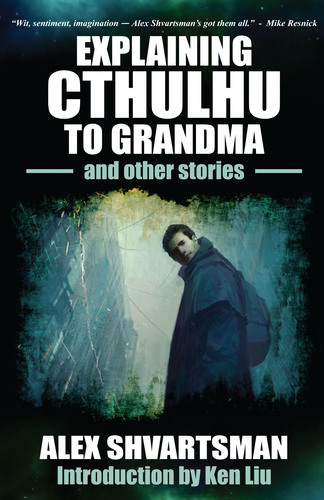What a difference a year makes.
At the onset of 2011 I had two stories published in token-paying ‘zines. I set myself a nearly-unattainable goal of making ten more story sales by the end of the year. Not even in my wildest dreams did I imagine that I’d make pro-paying sales, join SFWA, and have a story of mine selected for use in a state-wide aptitude test by the NJ Board of Education. Meanwhile, I have friends whose imagination and writing ability blow me away — yet they still haven’t made their first sale.
So what’s my secret, you ask? I figured out and implemented an amazing strategy that resulted in the total of 19 story sales in 2011 (including stories submitted in late 2010). My secret formula is this:
1. Write lots of stories.
2. Submit them like crazy.
That’s it. That’s the big secret. Let’s go over that in detail:
1. Write lots of stories.
You must keep writing whether you feel like it or not, at the time. You must tinker with drafts you aren’t satisfied with and outline new ideas. You must add words to a story you’ve been slowly working on for months — even if you’re half-convinced at that point that your underlying idea is terrible and the writing is worse. By the time you’re finished, that might end up being one of the best stories you’ve ever written.
Writing on a regular basis makes you better at it. I look back at the stories I wrote a year ago, and I can see tangible improvement. I’m sure that will continue to be the case for a long time to come. Like any other craft, you hone your skills by practicing for hundreds of hours. You also tend to get rusty when you stop.
One good method for maintaining your creative output is to set yourself a daily writing goal. 500 words works for many people. That’s 500 new words — doing revisions and tinkering with your older manuscripts doesn’t count. If you’re an organized person with a stable schedule, you’ll be able to maintain a daily writing routine. You’ll also quickly discover a number that works for you. Some lucky souls can plug away at their keyboards and produce 1000 or even 2000 quality words a day. Others find 500 to be too challenging. If you are in the latter category, don’t despair. Even at 250 words written every day you can have an entire novel draft finished by the end of the year.
This works great if you’re in control of your schedule. Others have day jobs, family commitments, and other important stuff in their lives that may preclude them from writing daily. I belong firmly in this category. In this case, an initiative like Write1Sub1 may be an excellent substitute.
I joined W1S1 as it was being launched in late 2010, committing to write and submit a new story *every week* in 2011. While I have not always stuck to this schedule, it did constantly push me to increase my output. I made up for some skipped weeks with bursts of productivity and managed to finished an impressive number of stories in the past year — far more than I would have written without this self-imposed metric. Needless to say, I will continue to participate in Write1Sub1 in 2012, and you should consider it too.
2. Submit them like crazy.
As I wrote above, coming up with new material is the hard part. Submitting is easy. At least that’s the case for me. Other writers I know of have no problem writing new tales, but getting them to consistently submit their work for publication is more difficult than herding cats.
Some people have a hard time dealing with rejection (and there’s LOTS of rejection to be had, even if you’re a pro). Others struggle under the mountain of their creative inventory, uncertain of the status of their submissions, which stories have been to which markets, and which are idling in the dark corners of their hard drive.
Over the course of the previous year I’ve learned (or am still learning) the following facts about submissions:
* Never self-reject. If you think that your story might not be good enough for a specific magazine and you choose not to send it in, your end result is an equivalent of a rejection. If you *do* submit your story there, rejection becomes only a worst-case scenario.
* Submit your story to the best markets and continue to submit it until you run out places you can possibly stick it. Given the breadth of speculative fiction markets cataloged on sites like duotrope.com and ralan.com this shouldn’t happen for years. In the 18 months or so since I began writing, I have yet to retire a story (though I’ve tinkered with them plenty, to make sure that the level of writing in each story is the best I can currently manage)
* Don’t let a harsh personal rejection faze you. In 2011 I’ve had two separate instances where an editor rejected a story and ripped it to shreds in their comments — and then the story sold to the very next market I sent it to, with *zero* changes made. Just like with anything else in life, one editor’s trash is another editor’s treasure.
* Don’t be mad at the editors for “not getting” your story. You may disagree with them on the specific feedback they provide, but recognize that they took the time to make the comments in the first place. Every decent editor is inundated with hundreds of submissions. The fact that they offered you feedback instead of a form rejection is a gift, and should be treated as such.
* Don’t let the story languish on your hard drive. Send it out there. If you get a rejection, try to resubmit it somewhere else within 24 hours.
* New markets open all the time. If there isn’t a suitable market open for a particular story you have, chances are one will pop up in the next month or two. However, it’s even more likely that you haven’t looked hard enough. After a year and a half, I’m still discovering “new” places to submit to, all of which have been around far longer than I’ve been writing.
* Maintain a database tracking your submissions, so you always have a clear idea of where they’ve already been, and what isn’t out on submission at the moment.
So yeah — I’ve been submitting like crazy. In the past year I’ve made a total of 150 submissions (including reprints). Here are my annual statistics:
Submitted: 150
Currently out on submission: 18
Lost / Never responded: 2
Rejected: 114
Accepted: 16
The breakdown of accepted stories by market type:
Pro Pay ($0.05+/word): 5
Semi-pro ($0.01 – $0.05/word): 7
Token (under $0.01/word or royalty pay): 4
I sold a total of 19 stories in 2011. Of those, 17 were original stories and 2 were reprints. Two were micro stories (one Twitter length and one 100-word), 8 were flash (under 1000 words) and the rest ranged between 1200 and 5000 words.
In 2012 I’ll continue to write lots of stories and bombard editors with my submissions. I’m confident I can break my record of 150 subs. In fact, I think I’ll break 200.
If you want to see your fiction published in 2012, then so should you.








Solid advice, Alex! This would make a great guest post on the W1S1 site. Tweet me if you’d be interested, and may 2012 be even more of a success for your writing and persistent subbing.
Cheers, Alex.
I needed to be reminded of this. Especially the Self Rejection thing.
I’ll send out the story I hate most to a pro market, lol.
Congratulations on your success.
As I heard John Ashmead say at a con, “How DARE you reject a story at MY magazine! Only I can do that!”
Alex, congratulations. That is a very impressive year.
Thanks so much for sharing this information. It’s very encouraging to those of us getting to the point where we’re planning on sending work out.
My problem seems to be that a lot of the magazines in the UK I’ve ‘found’ are generally elderly lady types, or women’s magazines. Not really the genre I write.
I shall keep looking though!